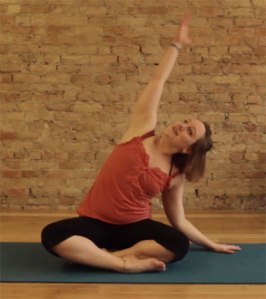 Whenever I am asked to describe the difference between yoga and pilates, I am first struck by all the similarities – especially with pilates matwork, which is what I teach. Both are forms of mind-body fitness with a focus on breathing, mindfulness and quality (over quantity) of movement.
Whenever I am asked to describe the difference between yoga and pilates, I am first struck by all the similarities – especially with pilates matwork, which is what I teach. Both are forms of mind-body fitness with a focus on breathing, mindfulness and quality (over quantity) of movement.
In pilates, all movements begin with the activation of the deep core muscles. These muscles are the body’s basis for efficiently fighting gravity, and they are designed for the long-term work of holding the spine in good alignment and supporting the use of the limbs.
The major difference in practice is that whereas yoga tends to focus on the big picture, pilates is prone to compartmentalizing the body. This is especially helpful for people with mobility issues, and those recovering from injury. When something goes wrong in one part of the body, it can be necessary to address that specific part individually at first. Pilates principles would help find ways the core muscles can better support that body part in motion while regaining strength.
I often say that yoga is about finding the movement in stillness (feeling the natural movements of the breath while holding steady in a pose) and that pilates is about finding the stillness in motion (using core support to create smooth, steady movements). But the truth is that the two forms are inextricably linked (Joseph Pilates himself studied yoga, among other disciplines) and are a wonderful complement to each other.
 You can think of it in the yoga terms of Organic and Muscular energy. Lots (but obviously not all) of yoga poses encourage the use of Organic energy, the naturally expansive energy that is felt in big, reaching movements and poses that increase flexibility. Organic energy movements, often linked with the inhale, feel open and free (especially for tight, stiff muscles). In pilates, the exercises focus on the use of Muscular energy, which is linked with the natural contraction of the exhale. Muscular energy pulls the muscles towards the bones and the bones toward the midline of the body, which feels strong and stable. For people with loose joints (like myself) as well as those with scoliosis or mobility issues, that stability is essential to enjoying expansive, Organic movements without fear of injury.
You can think of it in the yoga terms of Organic and Muscular energy. Lots (but obviously not all) of yoga poses encourage the use of Organic energy, the naturally expansive energy that is felt in big, reaching movements and poses that increase flexibility. Organic energy movements, often linked with the inhale, feel open and free (especially for tight, stiff muscles). In pilates, the exercises focus on the use of Muscular energy, which is linked with the natural contraction of the exhale. Muscular energy pulls the muscles towards the bones and the bones toward the midline of the body, which feels strong and stable. For people with loose joints (like myself) as well as those with scoliosis or mobility issues, that stability is essential to enjoying expansive, Organic movements without fear of injury.
Although they all subscribe to the six basic principles of concentration, control, center, flow, precision, and breathing, there are many different styles that fit underneath the pilates umbrella (Stott, Winsor, Fletcher, etc), each with their own slightly different focus. I trained in the Body Harmonics method.
In my Pilates (and the pilates half of Fusion) classes, you will find that we do not use any of the big (and sometimes scary- looking) equipment. We rarely stand up, instead using a variety of positions close to the floor to address the core from multiple angles. All exercises are done slowly and mindfully with a focus on core support, typically moving one body part at a time while using deep muscles to hold the rest of the body steady.
Pilates exercises may look deceptively simple, but are a challenge to beginners and seasoned practitioners alike. As in yoga, we use bodyweight to strengthen muscles, occasionally adding props to modify the intensity of an exercise. To balance Muscular and Organic energy we end class with a cool-down stretch to lengthen the muscles used. We don’t ‘Om’ or talk about spirituality in pilates class, but we definitely go deep, linking the body and mind with the breath and cultivating the kind of well-being that is rooted in a strong, healthy body.
 Want to give it a try? Check out my Pilates Quick Fix video, or drop by Spanda Yoga Centre for a class:
Want to give it a try? Check out my Pilates Quick Fix video, or drop by Spanda Yoga Centre for a class:
Tuesday Pilates, 7-8pm (begins September 2nd)
Saturday Yoga-Pilates Fusion, 11:15am-12:30pm (ongoing)

